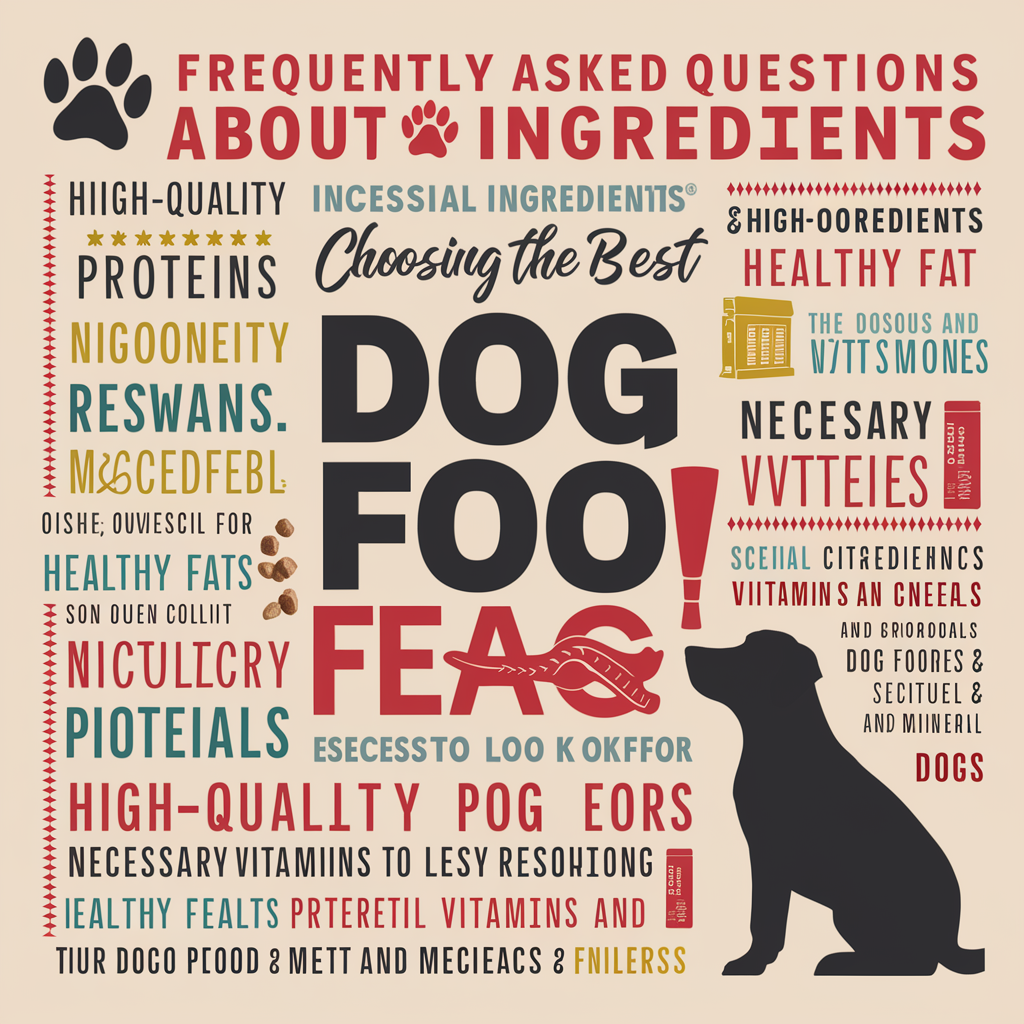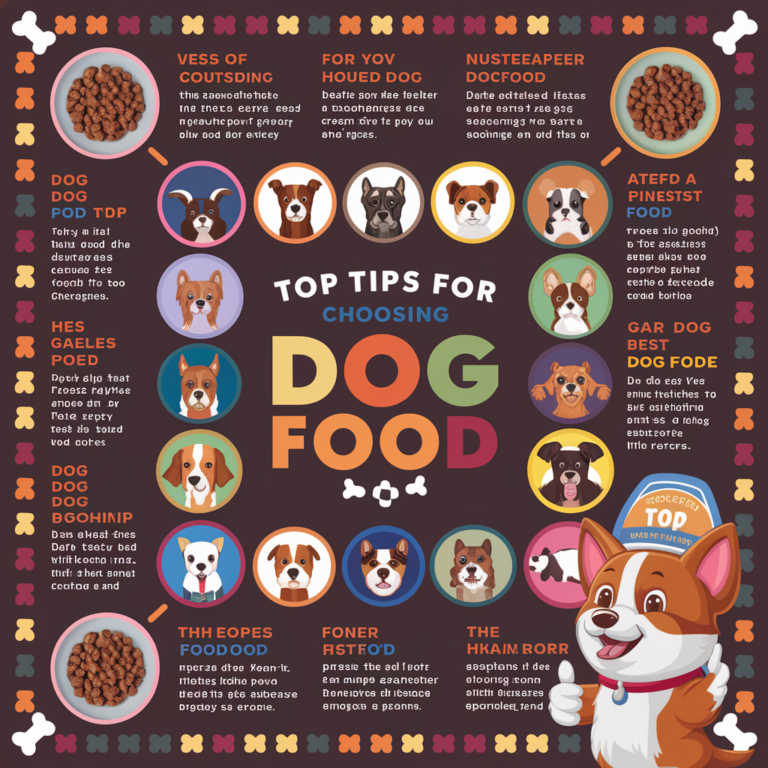Introduction
Choosing the right food for your dog is a crucial decision that affects their overall health, energy levels, and longevity. With so many options available on the market, it’s easy to feel overwhelmed. What ingredients should you look for? How do you know if a brand is trustworthy? This comprehensive guide will answer all your questions about what to consider when choosing dog food, providing you with valuable insights and actionable tips to ensure your furry friend gets the best nutrition possible.
Top Tips for Choosing the Best Dog Food
Why Choosing the Right Dog Food Matters
Dog food is more than just sustenance; it’s the cornerstone of your dog’s health. The right food can boost your dog’s immune system, maintain their weight, keep their coat shiny, and support their overall well-being. Conversely, poor-quality food can lead to health issues like obesity, allergies, and digestive problems. Understanding what goes into your dog’s food and making informed choices can significantly improve their quality of life.

Frequently Asked Questions About Choosing Dog Food
What Ingredients Should I Look For in Dog Food?
When choosing dog food, it’s essential to look at the ingredient list. Here are some key ingredients to look for:
- High-Quality Protein: Look for named animal proteins like chicken, beef, or fish. These should be the first ingredient listed, as dogs need protein to maintain muscle mass and overall health.
- Whole Grains: Ingredients like brown rice, barley, and oats provide essential carbohydrates and fiber.
- Vegetables and Fruits: These provide important vitamins, minerals, and antioxidants. Examples include sweet potatoes, carrots, blueberries, and spinach.
- Healthy Fats: Sources like chicken fat and flaxseed oil are essential for a healthy coat and skin.
- Probiotics and Prebiotics: These support digestive health by promoting a healthy balance of gut bacteria.
What Ingredients Should I Avoid?
Not all ingredients are beneficial for your dog. Avoid foods that contain:
- By-Products: These can include parts of animals not typically consumed by humans and can be of questionable quality.
- Artificial Preservatives: Ingredients like BHA, BHT, and ethoxyquin can be harmful over time.
- Artificial Colors and Flavors: These are unnecessary additives that can cause allergic reactions and other health issues.
- Excess Fillers: Corn, wheat, and soy are often used as fillers and provide little nutritional value while potentially causing allergies.
How Do I Know If a Dog Food Brand is Trustworthy?
Choosing a trustworthy brand is crucial. Consider the following:
- Research the Manufacturer: Look for brands with a good reputation and positive reviews from other pet owners and veterinarians.
- Check for Recalls: Ensure the brand hasn’t had frequent recalls, which can indicate quality control issues.
- Look for Certifications: Certifications from organizations like the Association of American Feed Control Officials (AAFCO) ensure that the food meets certain nutritional standards.
Should I Choose Wet or Dry Dog Food?
Both wet and dry dog food have their benefits:
- Wet Dog Food: Typically has higher moisture content, which can be beneficial for dogs who need extra hydration or have dental issues. It’s also usually more palatable.
- Dry Dog Food: More convenient to store and serve, helps with dental health by reducing plaque and tartar buildup, and is often more cost-effective.
How Much Should I Feed My Dog?
The amount of food your dog needs depends on their age, weight, activity level, and overall health. Most dog food packages provide feeding guidelines, but it’s always best to consult with your veterinarian to tailor the amount to your dog’s specific needs.
Are Grain-Free Diets Better for Dogs?
Grain-free diets have become popular, but they are not necessary for all dogs. Some dogs have grain allergies or sensitivities, and grain-free options can be beneficial for them. However, whole grains can be a valuable part of a balanced diet for most dogs, providing essential nutrients and fiber.
Is Homemade Dog Food a Good Option?
Some pet owners prefer to prepare homemade dog food to ensure complete control over their dog’s diet. While this can be a good option, it requires a thorough understanding of canine nutrition to ensure your dog gets all the necessary nutrients. Consulting with a veterinarian or a pet nutritionist is crucial if you decide to prepare homemade dog food.
How Important is the Food’s Palatability?
The taste and smell of the food are crucial for ensuring your dog eats their meals enthusiastically. Even the healthiest dog food won’t be beneficial if your dog refuses to eat it. Finding a balance between nutrition and palatability is essential.
Key Points to Consider When Choosing Dog Food
1. Age and Life Stage
Dogs have different nutritional needs at different life stages. Puppies require more protein and fat to support their growth, while senior dogs might need fewer calories and more fiber to maintain a healthy weight. Always choose a food that’s formulated for your dog’s specific life stage.
2. Breed Size
Small and large breeds have different dietary requirements. Small breeds often have faster metabolisms and might need more calorie-dense food, while large breeds can benefit from food that supports joint health and contains controlled levels of calcium and phosphorus.
3. Health Conditions
If your dog has specific health conditions such as allergies, diabetes, or kidney disease, their diet should be tailored to manage these issues. There are specialized dog foods available that cater to various health conditions. Always consult with your veterinarian to choose the best option.
4. Activity Level
Highly active dogs, such as working dogs or those involved in sports, require more calories and nutrients to sustain their energy levels. Conversely, less active or sedentary dogs might need a diet with fewer calories to prevent weight gain.
5. Food Allergies and Sensitivities
Food allergies and sensitivities can cause various symptoms in dogs, from skin issues to digestive problems. If you suspect your dog has a food allergy, consult your veterinarian. They might recommend an elimination diet or hypoallergenic dog food to identify and manage the allergy.
6. Budget
While it might be tempting to choose the cheapest option available, investing in high-quality dog food can save you money in the long run by preventing health issues and reducing veterinary bills. Look for the best quality food within your budget, focusing on ingredients and nutritional value.
The Impact of Nutrition on Your Dog’s Health
1. Weight Management
Maintaining a healthy weight is crucial for your dog’s overall health. Obesity can lead to various health issues, including diabetes, heart disease, and joint problems. Feeding your dog the right amount of high-quality food can help them maintain a healthy weight.
2. Digestive Health
Proper nutrition supports your dog’s digestive health. Foods with probiotics, prebiotics, and high-quality fiber can promote a healthy gut, reduce the risk of gastrointestinal issues, and improve nutrient absorption.
3. Skin and Coat Health
A shiny coat and healthy skin are signs of good nutrition. Omega-3 and omega-6 fatty acids, vitamins, and minerals in dog food can help maintain your dog’s skin and coat, reducing the risk of dry skin, dandruff, and shedding.
4. Energy Levels
The right balance of proteins, fats, and carbohydrates provides the energy your dog needs to stay active and playful. High-quality dog food ensures your dog has sustained energy levels throughout the day.
5. Immune System Support
Proper nutrition is essential for a strong immune system. Vitamins, minerals, and antioxidants in dog food help boost your dog’s immune response, protecting them from illnesses and infections.
How to Transition Your Dog to New Food
Switching your dog’s food should be done gradually to avoid digestive issues. Here’s a step-by-step guide:
- Days 1-2: Mix 25% of the new food with 75% of the old food.
- Days 3-4: Mix 50% of the new food with 50% of the old food.
- Days 5-6: Mix 75% of the new food with 25% of the old food.
- Day 7 onwards: Feed 100% of the new food.
Monitor your dog for any signs of digestive upset, such as diarrhea or vomiting, and consult your veterinarian if any issues arise.
The Role of Supplements
While a balanced diet should provide all the necessary nutrients, some dogs might benefit from additional supplements. Common supplements include:
- Omega-3 Fatty Acids: For skin, coat, and joint health.
- Probiotics: For digestive health.
- Glucosamine and Chondroitin: For joint support.
- Vitamins and Minerals: To address specific deficiencies.
Consult your veterinarian before adding any supplements to your dog’s diet to ensure they are necessary and safe.
Reading Dog Food Labels
Understanding dog food labels is crucial for making informed choices. Here are key elements to look for:
- Ingredient List: Ingredients are listed by weight. Look for high-quality proteins and whole foods.
- Guaranteed Analysis: Shows the percentages of crude protein, fat, fiber, and moisture.
- Nutritional Adequacy Statement: Indicates if the food meets AAFCO standards.
- Feeding Guidelines: Provides recommendations on how much to feed based on your dog’s weight and activity level.
Statistics and Insights
Pet Food Market Trends
According to recent statistics, the global pet food market is expected to reach $113.08 billion by 2027, growing at a CAGR of 4.6% from 2020 to 2027. This growth is driven by increasing pet ownership and a rising awareness of pet health and wellness. As a result,
pet owners are more willing to invest in high-quality, nutritious food for their pets.
Impact of Diet on Dog Health
Studies have shown that a balanced diet can significantly improve a dog’s health and lifespan. For example, a study published in the Journal of Animal Science found that dogs fed a diet high in antioxidants and omega-3 fatty acids had reduced inflammation and better overall health.
Conclusion
Choosing the right dog food is a critical aspect of pet care that can profoundly impact your dog’s health and well-being. By understanding what to look for and what to avoid, you can make informed decisions that ensure your dog gets the nutrition they need to thrive. Remember to consult with your veterinarian to tailor your dog’s diet to their specific needs and conditions. With the right food, your dog will enjoy a healthier, happier life.
All about dogs
All about cats
All about birds
All about rodents.

